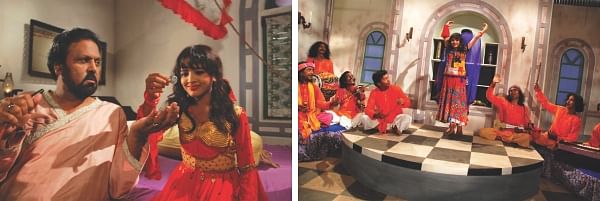| Home - Back Issues - The Team - Contact Us |
 |
| Volume 11 |Issue 36| September 14, 2012 | |
|
|
Cinema
Songs Muffled in Pain 'Ghetu Putro Komola' tells the story of an abusive practice that was once a popular form of entertainment in the haor (inundated field) areas of north eastern Bengal, where young adolescent Ghetu performers were the object of entertainment of the influentials Tamanna Khan As the voice of Asaduzzaman Noor relates the history of Ghetu gaan, a recent picture of Jolshukha, the birthplace of these songs, standing as a tiny, green island, appears in mind. It is of a boat, almost similar to the one shown in the first scene of 'Ghetu Putra Komola', cutting across the calm waters of the haor, carrying a wedding troupe. The loudspeakers attached to the boat play a popular Hindi item number “munni badnam huyi”, to which a bunch of young men dance hysterically. Amidst the vast body of water, reflecting the clear autumn sky with a misty green landscape in the distant, the wedding party's boat and its song appear totally out of place. Absent are the tunes of the folk instruments ektara or the khonjoni that capture the music of the ripples of the haor. 'Ghetu Putro Komola', the last film written and directed by Humayun Ahmed is the story of depraved desire and greed that led to the extinction of a genre of music which evolved from the serene beauty of the rainy seasons of north eastern Bengal. The magical storyteller Humayun Ahmed succeeds in holding the audience's attention throughout the film. Unlike his other films, Ahmed avoided using unrelated scenes meant to make the audience laugh, except for one or two instances. For example, the scene where the central character Komola alias Zahir and a male member of the snake charmer's troupe are seen sitting together, after being thrown out from the female quarters of the landlord's palace, does not make much sense.
Tariq Anam Khan does a credible portrayal of a landlord who justifies his lust and abuse of a child as an expression of power and social status. From the cold dominant orders of a landlord to the mental torture he ensues upon his wife to keep her in her place, the landlord never lets emotion override his show of might. Yet he does not fall short in his fatherly love for his daughter. The audience sees how the apparent child abuser turns into an ideal father to Phulrani. The landlord is in fact one of Ahmed's signature characters, displaying the varied traits of human behaviour, a conflicting combination of good and evil. However, like in all other Humayun Ahmed's films, it is the child artistes, who win over the audience's hearts. The deceased director deserves kudos for his choice of casting — the central character of Ghetu Putra Komola, the landlord's daughter Phulrani and Ghetu Putro's sister Mala. Mamun playing Komola does an excellent job bringing up the adolescent boy's fear, pain, playfulness and curiosity. Though still a child, he does not fail to understand the society's demeaning perception of the profession he has been forced into. The audience thus falls silent when he asks Shah Alam, the hired artist of the landlord, if he despises him. Unlike most of Ahmed's other films, Ghetu Putra Komola is not crowded with bizarre characters. As such, the house-help and lodgers in the landlord's residence, in one way or the other, contribute to the landlord's display of power. Shah Alam played by Agun is one example. He suffers in silence and tries to express his anguish through his art but fails to speak the truth or protest when a crime occurs in his very presence. The only character that shows some courage is that of Phulrani, the landlord's adolescent daughter. She pricks our conscience through her naïve questions, and her effort to befriend Zahir and protect him, in spite of the socio-economic barrier that stands between them. Even as a child she understands the grave injustice that infects her household. In fact, the last scene where Phulrani is seen shedding tears in Zahir's room with a lamp in hand, indicates how this tradition of sex slavery forced upon the adolescent performers of Ghetu gaan, came to an end. Humayun Ahmed's love for the natural and undiscovered beauty of Bengal is brought to the screen once again by clever camera work. In his last interview with The Daily Star, the renowned director had mentioned how he hoped that this film would interest a foreign audience– “When they watch the same area inundated at times and dry the next season”. So important was the camerawork to him that he had changed the cinematographer who failed “to grasp the essence” of what Ahmed wanted to present. He, no doubt, succeeded in portraying what he hoped to do. The music, which is very much a part of the film reflects Ahmed's love for our folk culture and his effort in preserving the same. Except for one, the lyrics of the rest of the songs are not objectionable. Even for that one song, the lyrics and dance moves have been made to look crude to portray how vulgarity became a part of Ghetu gaan. The same has to be said about the garish makeup and attire of Komola. In the small sphere of Bangla cinema, Humayun Ahmed has cut himself a niche. His films have brought back the middle-class to the cinema hall. The influence is still evident after the maestro's demise. It was difficult getting a single ticket on the first day of the show. The theatres buzzed with people, some of them bringing their children along, even though the film banners and advertisements clearly advised against it. Since the film deals with a sensitive topic, the producers and distributors should have mentioned the viewer's minimum age along with the message. The film “Ghetu Putra Komola” brings out a dark side of our history, which though non-existent now may have taken up new forms. We still see paedophiles lurking in different pockets of our society. Hopefully, the story's tragic end will inspire those who see to stand against all kinds of child abuse.
|
Copyright
(R) thedailystar.net 2012 |


 On the other hand, the presence of some characters is too short for the audience to develop an emotional connection. Tamalika Karmakar's role as Zahir's mother, suffers from this setback. Her grief could have been made more believable especially in the farewell scene between her and Zahir. The depiction of Zahir's day to day interaction with his mother could have made the bond between the characters stronger.
On the other hand, the presence of some characters is too short for the audience to develop an emotional connection. Tamalika Karmakar's role as Zahir's mother, suffers from this setback. Her grief could have been made more believable especially in the farewell scene between her and Zahir. The depiction of Zahir's day to day interaction with his mother could have made the bond between the characters stronger.